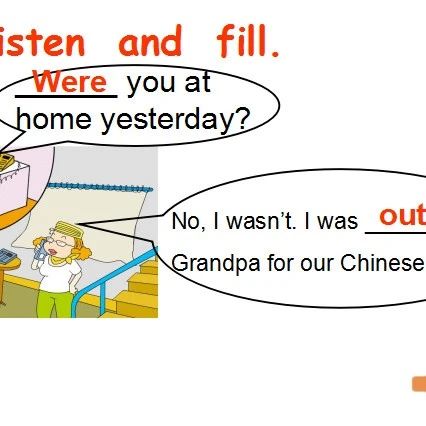【教案】外研版小学英语三年级出发点四年级下册m6教学设计

|
《英语》(新标准)(小学三起)四年级下册m6u1讲授设计 |
|||
|
教材分析 |
本模块的教学内容是谈论过去事物或人物的特征和状态。在第一单元中,讲述了tom给在美国的奶奶打电话。tom先问了伦敦今天和昨天的天色情况,接着又询问奶奶昨天是否在家而引出新句型的学习。在第二单元中,讲述了lingling给amy看自己爷爷的照片,介绍爷爷居住地过去与现在的不同 |
||
|
模块教学目标 |
一、 熟练掌握本模块的重点单词:yesterday, out, then, well, sun, lesson 句型:were you…? was it…? 二、 能够运用句型were you…? / was it…? 对人物或实物询问过去的特征和状态。 三、 通过学习本模块内容,乐于感知并踊跃尝试用英语表达交流的意识。 |
||
|
教学重点及难点 |
教学重点: 1. 掌握本模块重心单词和句型。 2. 能运用was, were询问过去的行为或事件。 3. 能在图片、情景等提示的帮助下,听懂并理解文本材料。 教学难点: 能够掌握本模块重点单词和句型,能够对事物或人物过去的特征和状态用英语进行询问。 |
||
|
教学辅助 |
OHP、课文动画、单词卡片等。 |
||
|
教学策略 |
以任务激发学习兴趣,在情境中体验感知。 |
||
|
教学过程 |
|||
|
第一课时教学设计 |
|||
|
教材分析 |
该课内容与学生已经学习过的第五模块内容相关联,学生在已学的一般过去时态陈述句的基础上进一步感知其一般疑问句的特征。它主要记叙了Tom给在美国的奶奶打电话询问昨天发生的事情。课文中was, were的问句结构与学生已经非常熟悉的am, is, are的问句结构相同,教师要引导学生感知语言、理解课文,达到学以致用的目的。 |
||
|
课时教学目标 |
一、 1. 掌握本课单词:yesterday, well, thanks, sun, lesson 2. 掌握句型:Were you at home yesterday? Yes, I was. / No, I wasn’t. Was it sunny in London yesterday? Yes, it was. / No, it wasn’t. 二、 1. 能朗读课文,注意模仿语音、语调,并能按要求完成语句书写。 2. 能运用所学语言询问人物或事物过去的特征和状态。 三、 增强学习英语的兴趣,乐于参与各种课堂活动。 |
||
|
教学重点与难点 |
能运用所学语言询问人物或事物过去的特征和状态。 |
||
|
教学辅助 |
OHP, video, word cards |
||
|
教学策略 |
在教学的过程中设计合理的任务,以任务驱动教学,让学生在完成任务的过程中内化语言知识。 |
||
|
教学内容(含时间设置) |
教学活动 |
设计意图 |
|
|
教师活动 |
学生活动 |
||
|
Step 1: Warm up (about 3 minutes) |
1. 师生问候。 T: Good morning, boys and girls. Ss: Good morning. 2. 以话题讨论形式引导学生走入活动1的语境。 T: Were you at school? Were you at the zoo? Were you at the park yesterday? (learn: yesterday) Ss: Yes, I was. / No, I wasn’t. 3. 借助相应词组理解单词out。 T: When we say “I was at school / at the park / at the zoo”, that means “I was out.” Can you guess the meaning of “out”? Ss: 不在家的,在外面的。 4. 听并跟读活动1。 |
以学生亲身生活引入课文活动中,导入自然,感受真切。 |
|
|
Step 2: Lead in (about 2 minutes) |
呈现本课的学习任务。 T: After learning the new lesson, we’ll make a survey. Ask your partner where he / she was yesterday. |
导入本课课题。 |
|
|
Step 3: Presentation (about 20 minutes) |
1. 背景介绍。 T: Tom is not out. He is at home. He is calling his grandma. 2. 看活动2第一部分,填一填。 (learn: well) 3. 听两人谈论天气的部分,回答问题: Is it sunny in London? Was it sunny in London? (对比两个问句进行反复问答练习。) 4. 想一想,Sam 为什么总是问天气。 T: Why does Tom ask the weather? Ss: Tom likes sunny weather. He wants to play in the sun. (learn: sun, play) 5. 继续听并完成填空。 (learn: Chinese lesson) 6. 听课文并跟读。 |
教师利用问题、填空的形式,引导学生体验文本,不断思考,通过有梯度的活动设计,层层深入文本故事。 |
|
|
Step 4: Practice and Extension (about 13 minutes) |
1. 完成课本活动3. 2. 完成本课任务。 T: Let’s make a survey. Ask your partner where he / she was yesterday. |
巩固本节课所学重点内容,鼓励学生完成任务,学以致用。 |
|
|
Step 5: Emotional Education (about 2 minutes) |
You can try to talk about the things you did yesterday to your friends and you can share it with each other. |
培养学生学习英语的兴趣,鼓励学生运用所学语言谈论过去发生的事情。 |
|
|
Classroom Assessment |
Language Encouragement Stickers |
通过不同的奖励形式,有效激发学生学习英语的兴趣,让学生在英语课堂上想说、敢说。 |
|
|
Blackboard Design |
Module 6 Unit 1 Were you at home yesterday? — Were you at home yesterday? — Yes, I was. / No, I wasn’t. — Was it sunny in London yesterday? — Yes, it was. / No, it wasn’t. |
||
|
家庭作业: 1. Listen and read the text. 2. Talk about where you were yesterday with your parents. |
|||
|
《英语》(新标准)(小学三起)四年级下册M6教学设计 |
|||
|
第二课时教学设计 |
|||
|
教材分析 |
本课时的课文情景是Lingling给Amy看自己爷爷的照片,并告诉Amy爷爷现在深圳。Amy知道现在的深圳是一座大城市,而Lingling告诉她,以前深圳只是一个小渔村,由此展开了本课的话题,了解深圳过去与现在的不同。通过对这一课的学习帮助学生进一步复习was, were的用法,同时帮助学有余力的同学进行适当的拓展练习。 |
||
|
课时教学目标 |
一、 理解并运用本课重点单词及目标句型:was, were, village Shenzhen is a big city now. Was it a big city then? No. It was a small village then. 二、 1. 能正确理解并运用本课的重点单词和句型。 2. 能朗读课文,注意模仿语音、语调。 3. 能运用was, were描述人物或事物过去的特征和状态。 三、 学习英语的兴趣。 |
||
|
教学重点与难点 |
运用was, were描述人物或事物过去的特征和状态。 |
||
|
教学辅助 |
OHP, video, word cards |
||
|
教学策略 |
在情境中体验感知。 |
||
|
教学内容 (含时间设置) |
教学活动 |
设计意图 |
|
|
教师活动 |
学生活动 |
||
|
Step 1: Warm up and Lead in (about 2 minutes) |
1. 看图片,指一指,说一说,并回答问题。 T: Now he is strong. Was he strong then? Ss: Yes, he was. 2. Amy和Lingling 也在谈论一些过去的照片,我们一起看看,照片上的人物是谁,他在什么地方呢? |
对比was, were的功能及用法。 |
|
|
Step 2: Presentation (about 18 minutes) |
1. 听一听,回答问题。 T: Where is he? Ss: He’s in Shenzhen. (请学生欣赏当前深圳的图片,感受深圳是个大城市。体会并理解:Shenzhen is a big city now.) 2. 继续听并回答问题。 T: Was it a big city then? Ss: No. It was a small village. (请学生欣赏多年前深圳的图片,感受深圳过去是个小村庄。体会并理解:Shenzhen was a small village then.) 3. 听录音并跟读。 4. 有感情的读对话。 |
让学生走进文本故事情境,层层设疑:Where is Lingling’s grandpa? He is in Shenzhen. Shenzhen is a big city now. 继续抛出问题:Was it a big city then? No. It was a small village. 在文本故事情境中,反复强化is, was的功能;并通过观看深圳图片资料,增强情感体验。 |
|
|
Step 3: Practice and Extension (about 8 minutes) |
1. 完成活动3,看图片,提出问题并答一答。 2. 学生小组讨论家乡的变化,然后做报告。
|
通过两两合作,小组合作,设计Ask and answer. Talk and report等活动,让学生在真实的语境中进行语言的巩固和内化。 |
|
|
Classroom Assessment |
Language Encouragement Stickers |
通过不同的奖励形式,有效激发学生学习英语的兴趣,让学生在英语课堂上想说、敢说。 |
|
|
Blackboard Design |
Module 6 Unit 2 Was it a big city then? Shenzhen is a big city now.
Was it a big city then? No. It was a very small village then. |
||
|
家庭作业:1. Listen and read the texts of this module. 2. Talk about what you |
|||
本文链接: https://www.yizhekk.com/0248312552.html








